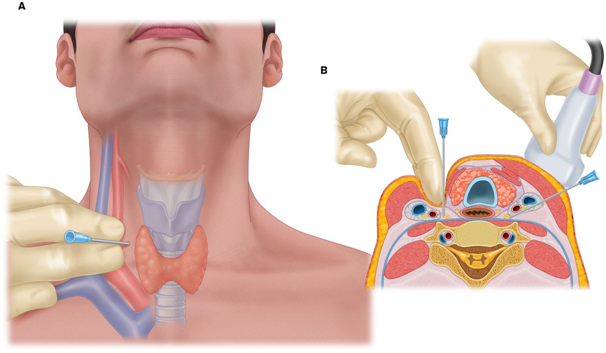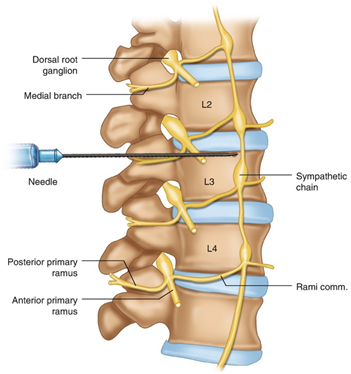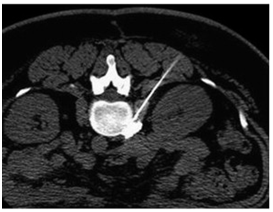| Category | Sympatholysis - Sympathetic Block (CRPS) |
Lumbar sympatholysis and Cervical sympatholysis (stellate ganglion block)
Complex regional pain syndrome (CRPS) is a chronic persistent painful condition. The pain is very severe and debilitating and usually affects arms, legs, hands, or feet. The condition commonly develops because of a soft tissue injury, sprain, stroke, or heart attack.
Persistent throbbing or burning pain that worsens over time
Warmth, redness, swelling of the affected region
Sensitivity to touch, heat, and cold
Changes in skin color, temperature, and texture
Changes in hair and nail growth
Joint stiffness, muscle spasm, and weakness
Difficulty moving the affected body part
Medical History: Your signs and symptom give important clues about your condition.
Physical examination: pain, temperature and texture changes, and other associated symptoms.
Confirmation of the diagnosis with a sympathetic nerve block.
Complex regional pain syndrome has no cure. The treatment options only help control the symptoms and perform daily activities. Many treatment options are available for this purpose, and it may take time to make an effective treatment combination.
NSAIDS
Corticosteroids: These may improve inflammation and improve mobility, i.e., prednisone.
Physical therapy helps improve mobility of the affected joint and the other regions.
If your pain does not respond to these treatment options, pain-blocking techniques are used:
Sympathetic nerve blocks: Sympathetic blocks like stellate ganglion block for hand and lumbar sympathetic block for legs have an essential role in treating CRPS.
Surgery: It is the last resort in the past, and its use was controversial. In a surgical intervention, a surgeon resects the sympathetic nerves involved in pain transmission to relieve pain.

The stellate ganglion is a collection of nerves (sympathetic) found at the level of the sixth and seventh cervical vertebrae (the last vertebra of the neck). The nerves are located in front of the vertebrae.
They are part of the sympathetic nervous system and supply the face and arm. These nerves are not involved with feeling or movement. Sometimes, after a nerve is sensitized by trauma, infection or other causes, the sympathetic activity can cause pain.
Blocking the sympathetic activity by anesthetizing the stellate ganglion may stop the pain. A stellate ganglion block (sympathetic block) is an injection of local anaesthetic into the front of the neck.
A stellate ganglion block can be either diagnostic—done to find the cause of a patient's pain—or therapeutic—done to relieve the pain.
During a stellate ganglion block, pain-relieving medicine is injected to the region where the ganglion lies. This may reduce the release of the chemical norepinepherine activating the pain sensitive nerves and reduce the pain.
The patient is usually sedated, and using Ultrasound or X-ray (fluoroscopy) guidance, a fine needle is placed near the stellate ganglion and anaesthetic is injected.
The patient will not feel numbness in the face. They will have a droopy eye and feel warmth in the face These effects are temporary and last a few hours. A pain diary is used following the procedure to track the response.
The doctor will clean the area over the region of interest and insert a small needle into the target area under imaging guidance. When it is in the correct position, they will inject the drug. They will remove the needle and cover the injection site with a small dressing.
We have very fast and competent working team (Consultant, fellow, clinical assistant, technician and ward assistant) which provide you comfortable atmosphere and ease your nerves. Usual time of stay is few hours
Every procedure carries a risk, although this is extremely small. The risk of infection with this procedure is extremely small as no incisions are made in the skin.
You can resume your work after 1 day if existing disease allows.

Lumbar sympatholysis can be an effective treatment for individuals suffering from chronic pain in the lower extremity as a result of various causes.
Lumbar sympatholysis is performable using modalities such as radiofrequency ablation (RF) or chemical neurolytic agents.
Fluoroscopy or CT frequently aids sympathectomy procedures, allowing the provider to navigate the bony landmarks and allow visualization of injected contrast material.
For this procedure in its various modalities, the patient is placed prone. Monitors are attached. Anxiolytic agents are an option. The lumbar region of the patient is prepped in a sterile fashion. Fluoroscopy/CT is used to identify the targeted region(s) in L2-L4. Local anesthesia is administered into the skin and subcutaneous tissue at the needle entry site Cutaneous temperature is usually monitored before and after at bilateral lower extremities to determine the efficacy of successful sympathetic blockade.
Lumbar sympatholysis can be an effective treatment option for patients suffering from chronic, intractable pain in the lower extremity as a result of various causes such as complex regional pain syndrome, post-herpetic neuralgia, inoperable peripheral arterial disease, phantom limb pain, erythromelalgia, or hyperhidrosis. The relief and symptom improvement resulting from the destruction of the lumbar sympathetic chain can last up to several years at a time.

The doctor will clean the area over the region of interest and insert a small needle into the target area under imaging guidance. When it is in the correct position, they will inject the drug. They will remove the needle and cover the injection site with a small dressing.
We have very fast and competent working team (Consultant, fellow, clinical assistant, technician and ward assistant) which provide you comfortable atmosphere and ease your nerves. Usual time of stay is few hours
Every procedure carries a risk, although this is extremely small. The risk of infection with this procedure is extremely small as no incisions are made in the skin.
You can resume your work after 1 day if existing disease allows.